These 8 Radar Detectors Are the Ticket to More Informed Driving
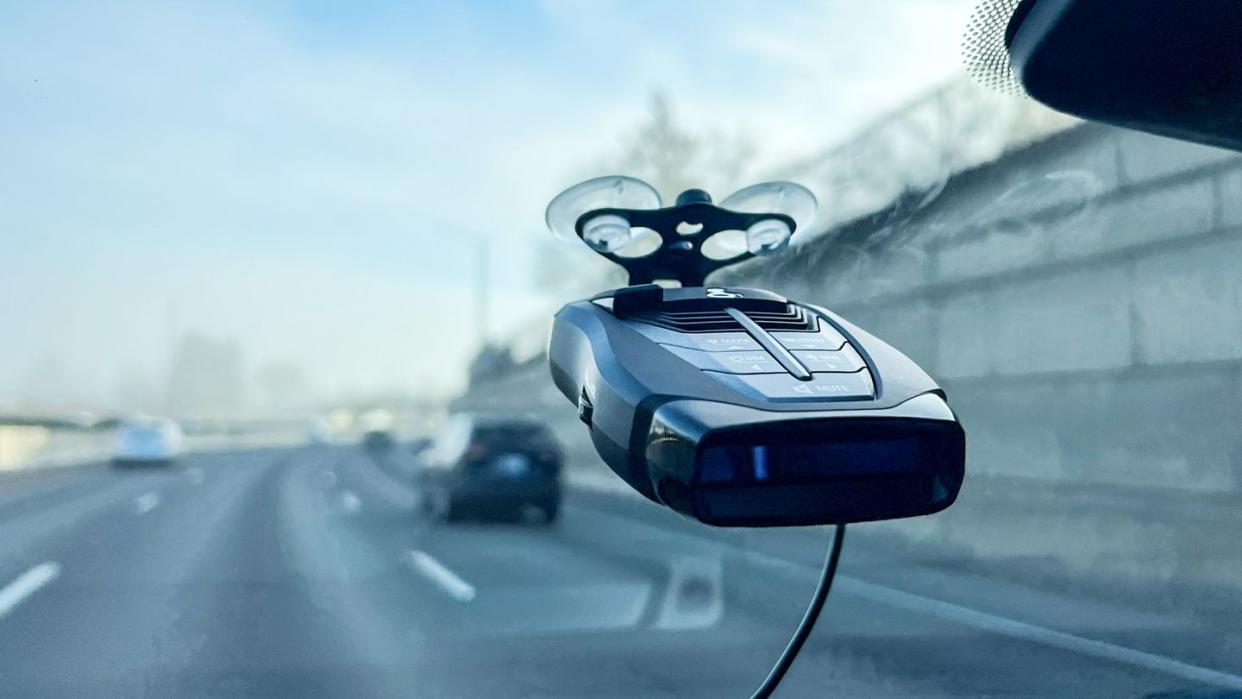
"Hearst Magazines and Yahoo may earn commission or revenue on some items through these links."
The best radar detectors can do more than just protect you from being the target of police radar and laser guns and keep you from receiving a speeding ticket. The latest detectors have features such as Bluetooth to connect to smartphone apps to show real-time traffic or an accident on your route, as well as GPS to mark red-light camera locations.
But the primary purpose of any decent detector is to sniff out various types of police radar—X, K, and Ka bands and their sub-variants—and laser signals that measure a motorist’s speed.
How well these devices sense the presence of police radar, do it accurately and quickly at a long distance, and indicate the direction of the signal so that drivers can slow their speed depends mainly on a detector’s effective range and number of antennas. Other important factors that impact this device's usefulness are how effectively a radar detector can filter out annoying false alarms caused by random non-police radar signals, the simplicity of its operation, and how clearly it conveys information via visual and audible alerts.
More guides for gearheads: Best Car Accessories ● Best Steering Wheel Covers ● How to Pick The Right Motor Oil for Your Car
Best Radar Detectors
Best Overall: Escort MAX 360c
Most Affordable: Cobra RAD 480i
Most User Friendly: K40-Platinum 100 RC
Best Value: Uniden DFR7
Best Display: Escort Redline 360c
The Expert: I’ve spent my entire journalism career testing car electronics and have owned several radar detectors going back to the mid-90s. As editor of Car Audio & Electronics magazine, I coordinated an annual radar detector test and have kept my eyes and hands on the products ever since, keeping tabs on new technology and features. I’ve also tested enough detectors over the years to get a sense of what makes them good or bad based on their controls and feature sets.
A Word of Warning
Before explaining how to pick a good radar detector, it’s important to point out that radar detectors are not universally legal in North America. In the United States, drivers are not legally allowed to use radar detectors in Virginia and Washington D.C. They’re also banned in most Canadian provinces, including Manitoba, Ontario, Quebec, New Brunswick, Nova Scotia, Prince Edward Island, and Newfoundland.
The details of the laws vary from state to state, including the penalties for breaking them, so I strongly recommend turning your detector off and putting it away while driving through states where they are banned. Highway patrol and police frequently use radar-detector detectors to sniff out the presence of a detector, so using one in a state where it’s illegal may actually increase your chances of getting pulled over.
What to Look for in a Radar Detector
How Radar Detectors Work
Radar detectors allow you to find radar and laser signals used by law enforcement to measure vehicle speed. Using one feels like using an AM/FM radio: The receiver in the detector tunes into active radar signals, just like a radio tunes in to active radio station frequencies. In the U.S., law enforcement typically uses one of three radar and laser types–the X, K, and Ka bands.
X band is the oldest form of radar used by law enforcement and is now uncommon. Its successor, K band, operates on a higher frequency and has lower power output, making it more difficult to detect at long distance. Ka band has a narrower beam pattern and lower power output than both X and K band, which makes it the most difficult type of radar to detect at long distances.
Police laser guns emit short bursts of infrared light that reflect off a vehicle and return to the device. Unlike radar that can usually be detected in advance, police point lasers at a specific vehicle, so drivers don’t get advance warning.
Range
If you want to avoid getting a ticket, you will need a radar detector that notifies you of an upcoming checkpoint far enough in advance for you to slow down if you’re going over the limit. That means your radar detector’s range effectively determines how useful it can be. Some detectors only track 100 feet away, where others can sense many miles away.
At the same time, keep in mind that a detector’s effective range varies at any given moment based on dense objects that could cause interference, and even the weather. Given that, many companies avoid telling you a detector’s range and lean on non-specific terms like “long range.” To address that ambiguity, I’ve tested the radar detectors below to get a sense of their relative ranges and accuracy.
Antennas
A radar detector’s antennas are like its “ears.” They allow the detector to search for radar and lasers in many different directions. The best radar detectors will have more antennas for detecting radar, which means you get better protection. Detectors with a single antenna only look for radar in front of a vehicle. More expensive models with multiple antennas can look behind and to the sides. The best of the best offer 360-degree detection, but full coverage is expensive.
Visual, audible, and voice alerts
Different detectors have different ways of letting you know when they pick up a radar or laser signal. Some high-end detectors use voice alerts which tell you specifically what’s coming. Others make specific sounds for each threat (X, K, Ka, laser) that you’ll need to learn. Most detectors also have a small screen with visual guides that show you the radar type, the strength of the signal, and the direction from which it’s coming.
False alert filtering
Radar detectors will sometimes pick up radar signals from other devices and mistake those for police radar guns. Anything from a radar-controlled garage door opener to a microwave could trigger a false alert—even adaptive cruise control on another car. Radar detectors use software to filter out frequent false alerts, learning where they frequently occur, and every one of them has a mute button so you can manually silence false alerts.
City and highways modes (sensitivity and selectivity)
Some detectors with longer range will feature a “city mode” that reduces its sensitivity for city streets and more crowded areas. This allows you to reduce the potential for false alarms when driving in a highly populated area with more possibilities for interference and false alarms.
Some detectors also have a “highway mode,” which does the opposite–increasing its range possibly at the expense of accuracy. This allows you to get more of a heads up when you’re most likely to need it… ahem, like if you’re speeding. (But you’d never do that, right?)
Both of these modes adjust the detector’s selectivity, a related spec that refers to a detector’s ability to detect police radar while ignoring other radar sources that operate on neighboring frequencies. A detector with high selectivity can differentiate between radar and laser and other signals. The best radar detectors offer a good balance between sensitivity and selectivity, and use software to note spots with frequent false alerts and filter them out.
GPS
Radar detectors with GPS give you the ability to mark and save the locations on recurrent speed traps and red light cameras so it can alert you before it detects a signal. More advanced models can access databases with crowdsourced trap and camera location data to give you more accurate warnings outside your everyday driving area, though you typically have to subscribe and pay an annual fee to access them.
Some detectors with GPS can also automatically switch between “city” and “highway” modes based on how fast you’re going.
Instant-On protection
Some police radar guns feature “instant-on” radar, which shoots a quick signal burst that measures your driving speed before a radar detector could pick it up. Some radar detectors have a feature called “instant-on protection” that can sense instant-on radar if police use it on a vehicle ahead of you.
Smartphone app
Some radar detectors can sync with a companion smartphone app which unlocks additional features. Some allow you to mark speed traps and traffic cameras like you would with a GPS-enabled detector. App-based GPS may include additional information, like posted speed limits and real-time traffic alerts.
How We Tested Radar Detectors
To test these radar detectors, I rented a radar gun and went to a deserted community-college campus in Southern California on a weekend. My assistant pointed a K-band radar gun at my test car, a 2017 Audi Q7, while I drove up a hill with a slight curve so that the vehicle would have to drive into the radar gun’s line of sight about 100 yards away. This gave me a sense of how quickly each detector could discover the radar signal, and most were within a few yards of each other.
I also tested several of the detectors in Portland, Ore., while driving a 2023 Chrysler Pacifica, and as luck would have it—or maybe bad luck for drivers without a radar detector—while doing a loop on Interstate 84, I encountered not one but two police officers on opposite sides of the freeway shooting Ka band that lit up the detectors under test. Finally, I drove an urban loop to get a feel for how well the detectors picked up radar and false alerts and how well they filter them out. I assessed them while stopped to fully explore the feature range of each detector including their controls and user interface.
Escort MAX 360c
The Escort Max 360c MK II has two antennas for comprehensive, long-range protection. Intuitive controls make it easy to use, and an OLED screen with several color schemes and arrows helps you quickly identify a risk.
GPS “auto-learn” pinpoints the location of frequent false alerts on your regular routes to block them. Likewise, it automatically adjusts its sensitivity based on your speed and shows posted speed limits.
When paired with your smartphone via the Escort Drive Smarter app, you get connected services such as real-time traffic reports, laser and radar location alerts from other connected detectors, and info on radar signal type and strength. It even connects to Apple CarPlay to show alerts on a vehicle’s dashboard display.
You will need to pay a subscription fee for the connected services after a three-month trial—either $24.95/year or $39.95 for three years. Even with the extra fees, though, its overall performance and feature set is unparalleled.
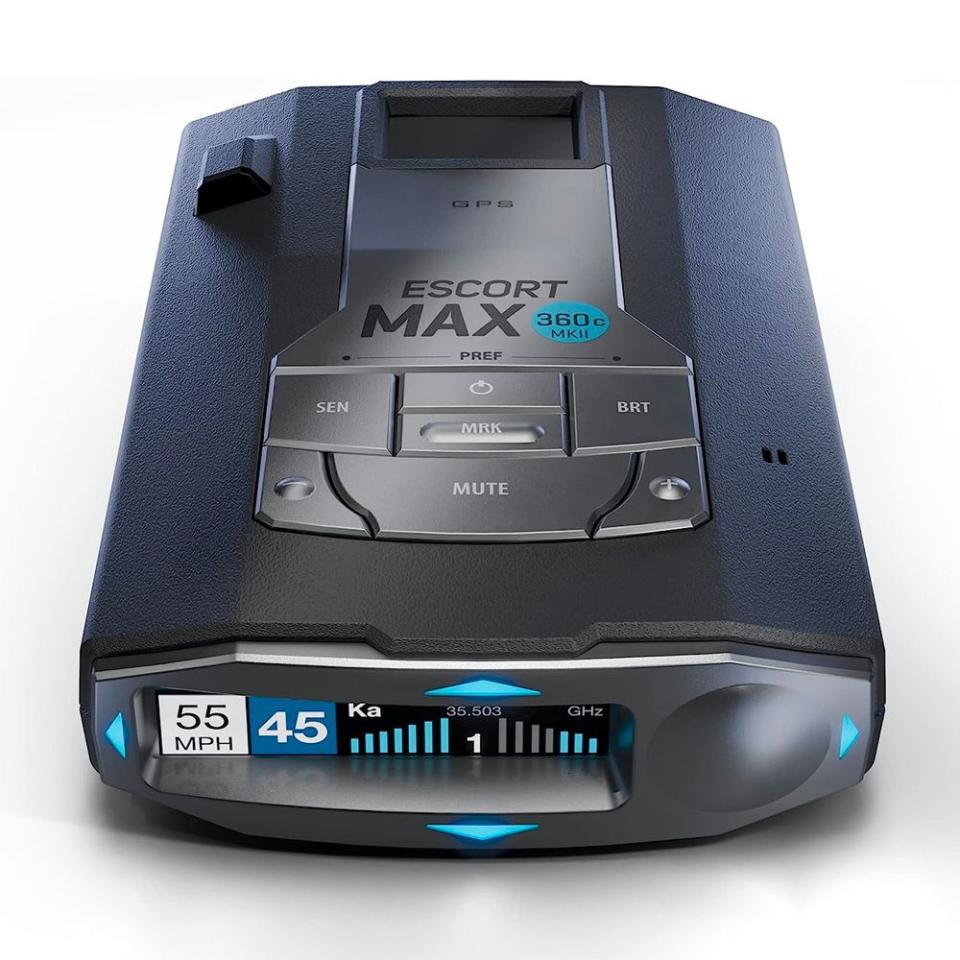
Escort MAX 360c
amazon.com
$619.99
RAD 480i
For those looking for low-cost but suitable protection from police radar, the Cobra RAD 480i provides the basics, including detection of all radar bands and laser signals. It has Bluetooth for connection to Cobra’s iRadar app, enabling you to get crowd-sourced real-time alerts on traffic, redlight/speed camera locations, and police activity in an area.
It also includes not-so-basic features like voice alerts in English and Spanish, and circuitry to reduce false alerts from signals generated by driver-assistance systems in newer cars. On the minus side, the display is monochromatic and the suction-cup windshield mount is a bit flimsy. I also encountered more false alarms with it than other detectors.
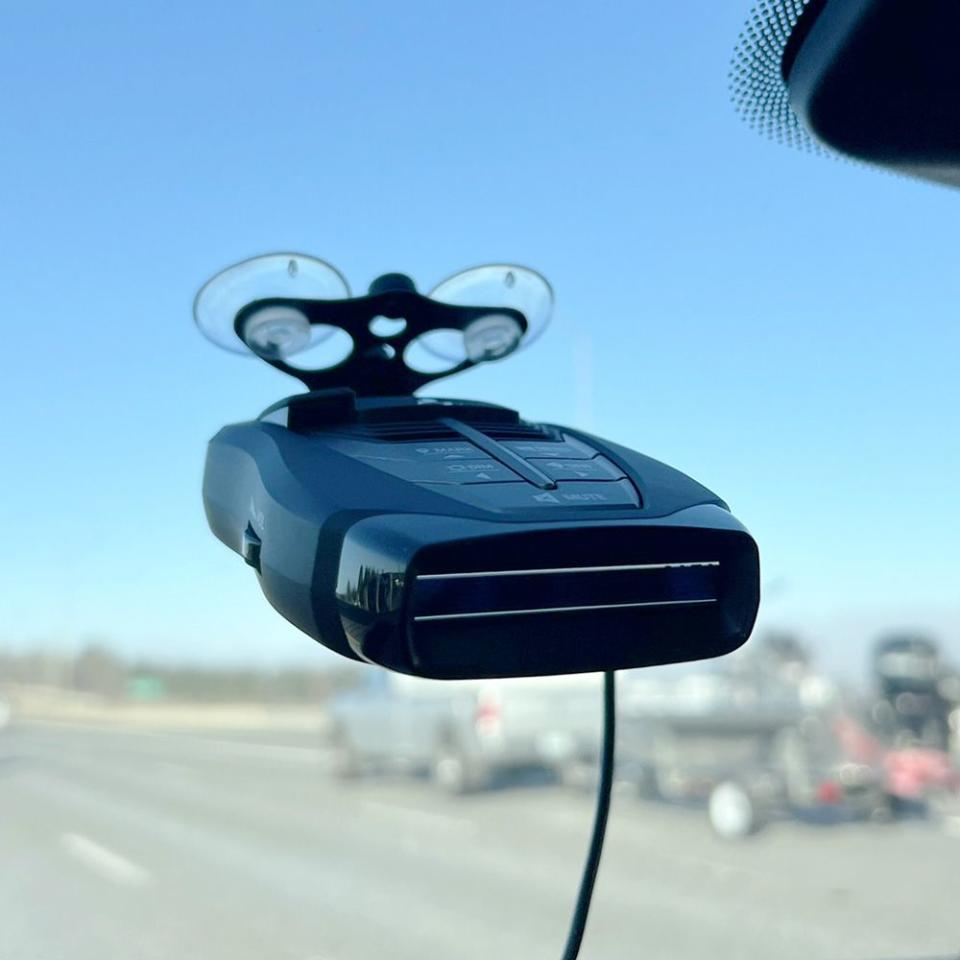
RAD 480i
amazon.com
$145.20
Platinum 100 RC
Almost all radar detectors share the same annoying flaw: You have to reach over to use the controls on the hardware—usually mounted on your windshield—whenever you need to adjust a setting. The K40 Platinum100 addresses this issue with a remote control, enabling you to operate the detector without reaching. It also has a customizable display that lets you choose one of five color schemes.
Of course, it also provides solid protection from laser signals and radar, including frequency-shifting MultaRadar systems, which are harder to pick up.
Last, but not least, it comes with a feature no other detector offers: 24/7 customer support and a one-on-one consultation with an expert from K40 Electronics to help you optimize the detector for your location unit and the way you drive.
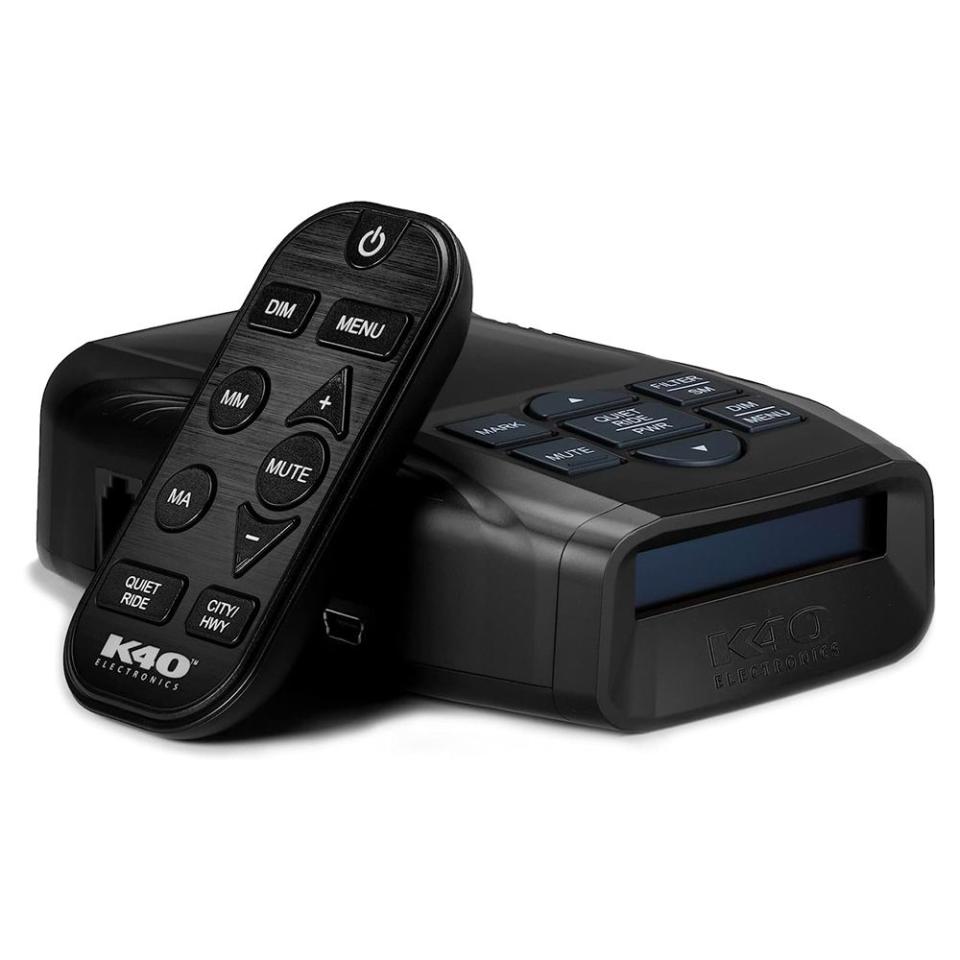
Platinum 100 RC
amazon.com
$669.95
DFR7
This low-cost detector has impressive range and all the requisite features, including GPS for low-speed false-alert muting, manual marking of up to 100 known radar locations, and speed-camera alerts.
The DFR7 uses front and rear antennas to detect all radar bands and laser, while alert info is clearly displayed on a monochrome OLED display. Voice warnings are available.
It’s false-alert filtering could be better, and can cause some undue anxiety out on the road. But the band settings are customizable, so learning which frequencies are used in an area you frequently drive can cut down on false alerts. The DFR7 can receive firmware updates from Uniden but it doesn’t have a smartphone app.
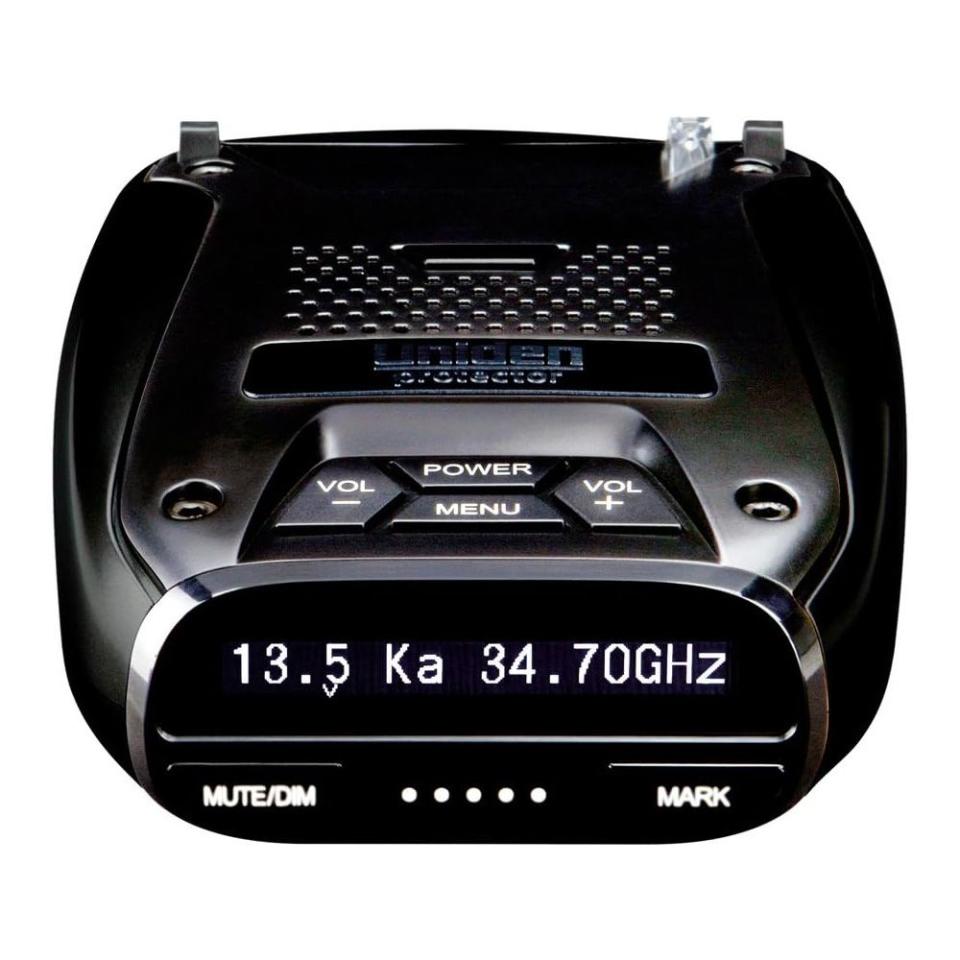
DFR7
amazon.com
$179.99
Redline 360c
This detector has dual-front and a single rear antenna for 360-degree protection and location accuracy, all at high detection distances. It senses all the latest radar signals, including frequency-shifting MultaRadar, and laser.
Where it really stands out is with its customizable multicolor OLED screen that features four directional arrows to show where signals are coming from. It also has both English and Spanish voice alerts.
Built-in GPS learns your route and allows marking speed-enforcement locations. The device has a database of speed-camera location, which also helps filter out frequent false alerts.
The Redline 360c connects to an Escort app using Bluetooth to share and receive updated crowd-sourced alerts, and it has a charging cord with a mute button and a magnet windshield mount.
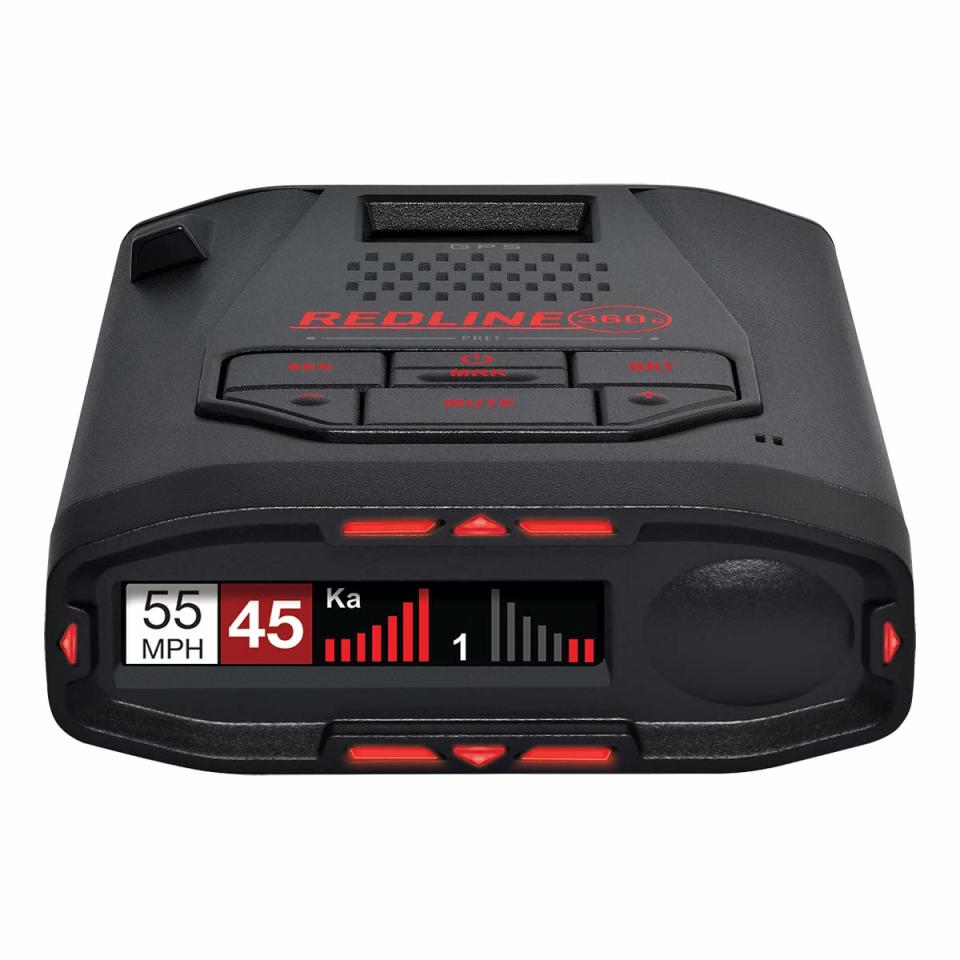
Redline 360c
bestbuy.com
$800.00
DFR9
This detector has a lot of appeal at a reasonable price and is easier to operate than some of the others recommended here. It offers adjustable sensitivity for X, K, and Ka radar detection and 360-degree laser detection. GPS allows for locating and locking out false alarms and marking red-light and speed cameras.
Its multi-color OLED display is a step up from the DFR7’s monochromatic display, and its Quiet Ride feature mutes alerts below a set speed. It also includes voice alert, an electronic compass, a signal-strength meter, city/highway modes, and database updates. The suction cup mount wasn’t very sticky, however, but the 12-volt USB power adapter has a mute button.
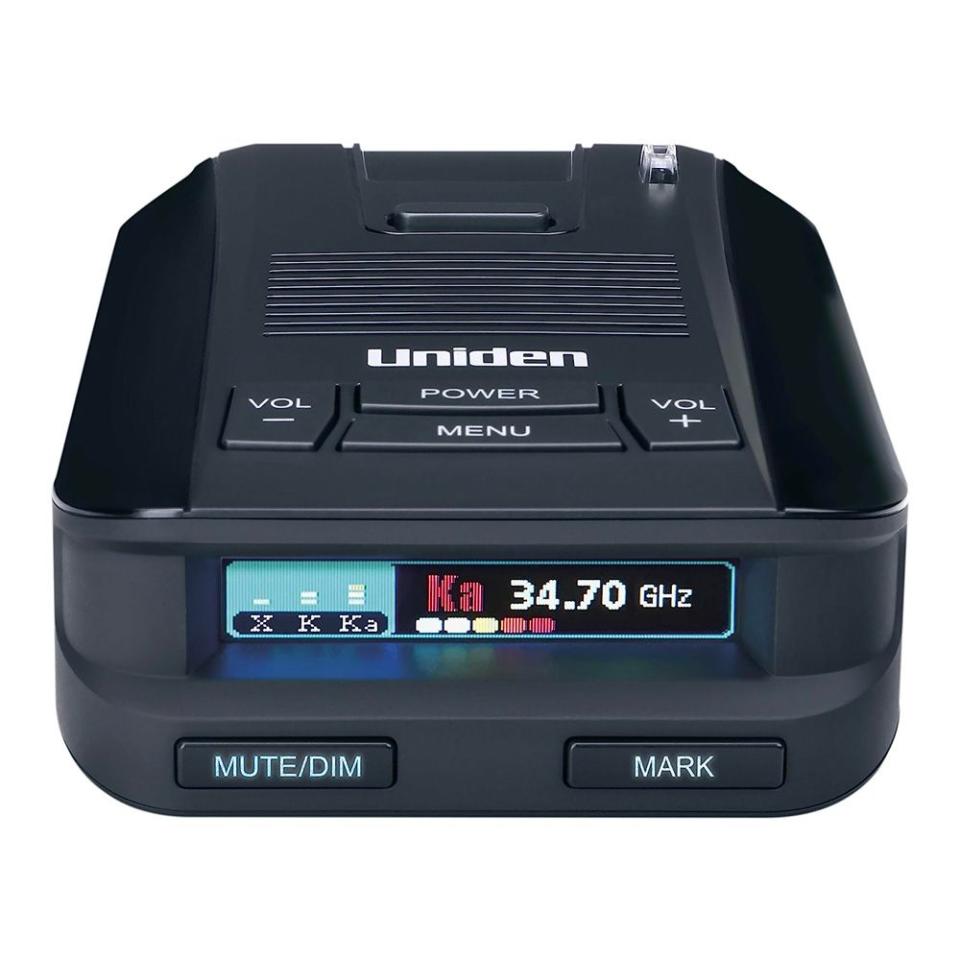
DFR9
amazon.com
$299.99
V1 Gen 2
Gen 2 of the venerable Valentine 1 identified threats at a greater distance than the other detectors thanks to patented technology that senses faraway signals with better accuracy.
Front and rear antennas provide 360-degree protection against laser and X, K, Ka, and super-wideband Ka radar signals. Controls are minimal with only up/down volume buttons on top and a multifunction button on the front that toggles between power, mode changes, and muting.
This detector's displays are also basic, including a “Bogey Counter” that combines an array of functions: the number of false alarms or “bogies," sensitivity-mode indicator, laser warning, and more.
The front side of the detector also includes a signal-type display, radar-strength meter, and arrows that are effective at identifying the direction of a threat, but the detector does not have built-in voice warnings.
It comes with both windshield and visor mounts and two 8-foot power cords that connect to the detector and 12-volt power socket using stable RJ11 landline-phone-style plugs. Built-in Bluetooth wirelessly syncs Apple and Android devices to the V1Connection app to share the detector’s display, but it doesn’t have GPS.
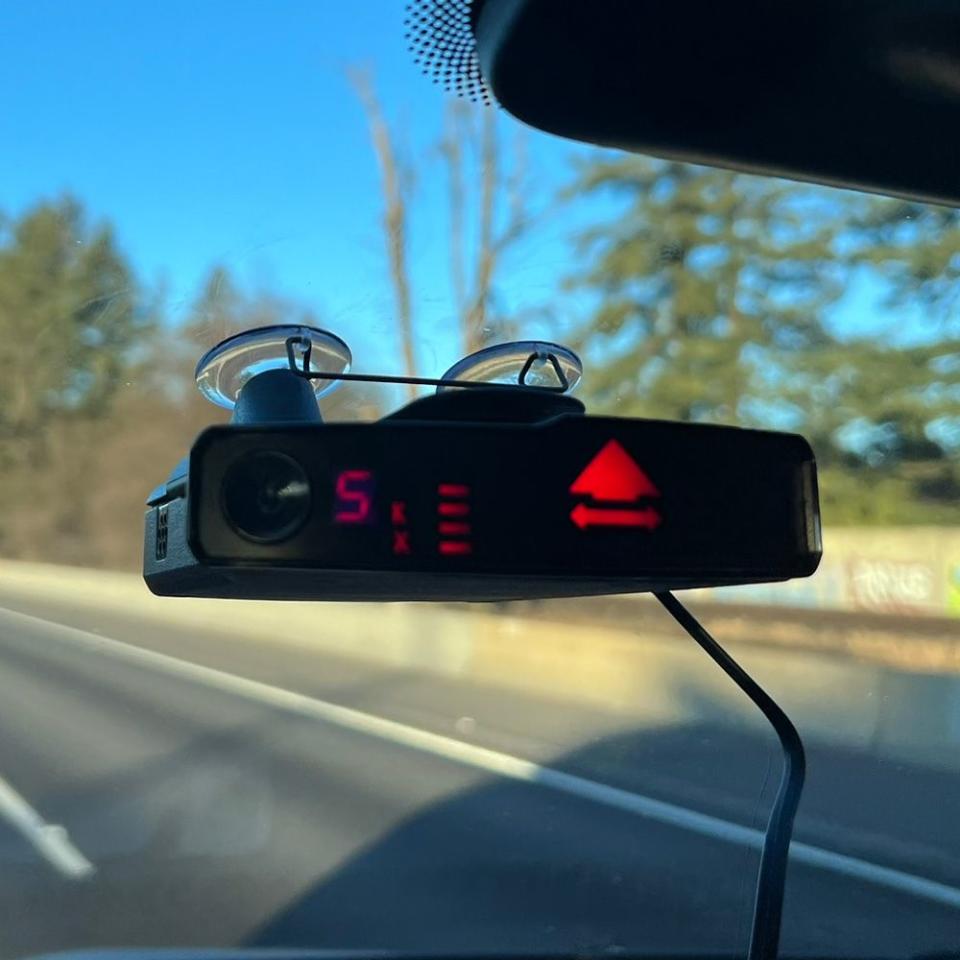
V1 Gen 2
amazon.com
$698.98
Doug NewcombR8
The Uniden R8 is one of the newest detectors I tested, one of the most feature filled, and one of my favorites. It has dual antennas to detect threats from four directions and signal strength indicators for each type.
It not only has voice alerts for the direction of the threat and band, but the alerts are even programmable and can be prioritized. The R8 can remember and automatically mute false alerts along your routes and it comes preloaded with a database of red light and speed camera locations.
The full-color display is one of my most liked as it shows lots of information that’s also easy to grasp at a glance. It filters out false alarms caused by signals coming from a car’s blind-spot monitoring and collision-avoidance systems. This detector comes with single and double suction-cup windshield mounting brackets, Velcro for dash mounting, a zippered carrying case, and a smaller neoprene carrying case, a power cord, and data cable.
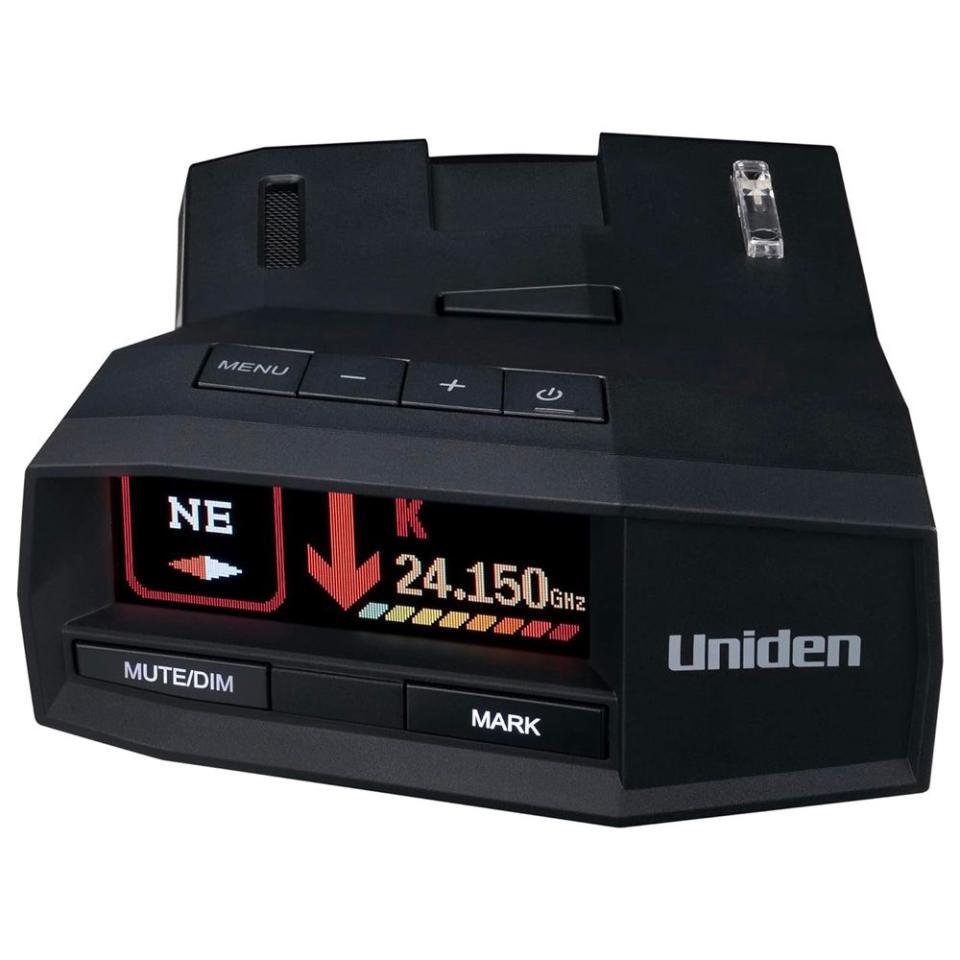
R8
amazon.com
$603.78
Get Up to Speed on Radar Detection with Expert Doug Newcomb's Tips.
Do police know if you have a radar detector?
Many law enforcement agencies use radar-detector detectors, especially in areas where the devices are restricted. Of course, they can also see your radar detector if you mount it on your windshield.
What happens if I get caught using a radar detector?
It depends on the jurisdiction. In Virginia, for example, drivers caught using a radar detector will be issued a $100 fine and police can confiscate the detector. Many US states, including California, New Jersey, and Pennsylvania, may issue a similar fine if you mount your radar detector on your windshield. (The fine is for using a windshield mount, not for the radar detector.)
What's the best way to mount your radar detector?
That’s a tricky question. Mounting the detector on your windshield makes it easy to see, but can earn you a fine in many states. Each state has its own specific regulations on windshield mounting for radar detectors and smartphones.
In Oregon, where I’m from, the law says you can’t mount a device that obstructs your view–and I’ve never had a problem. In California, where I tested the detectors, a device must be mounted in a 7-inch square in the lower corner of the passenger-side windshield or in a 7-inch square in the lower corner of the driver’s side.
Should I hide my radar detector when I'm not using it?
I usually hide my radar detector. They’re expensive, so leaving one out may attract thieves to break into your car. Many detectors come with a carrying case, and we like the ones with a convenient and quick-release magnetic mount.
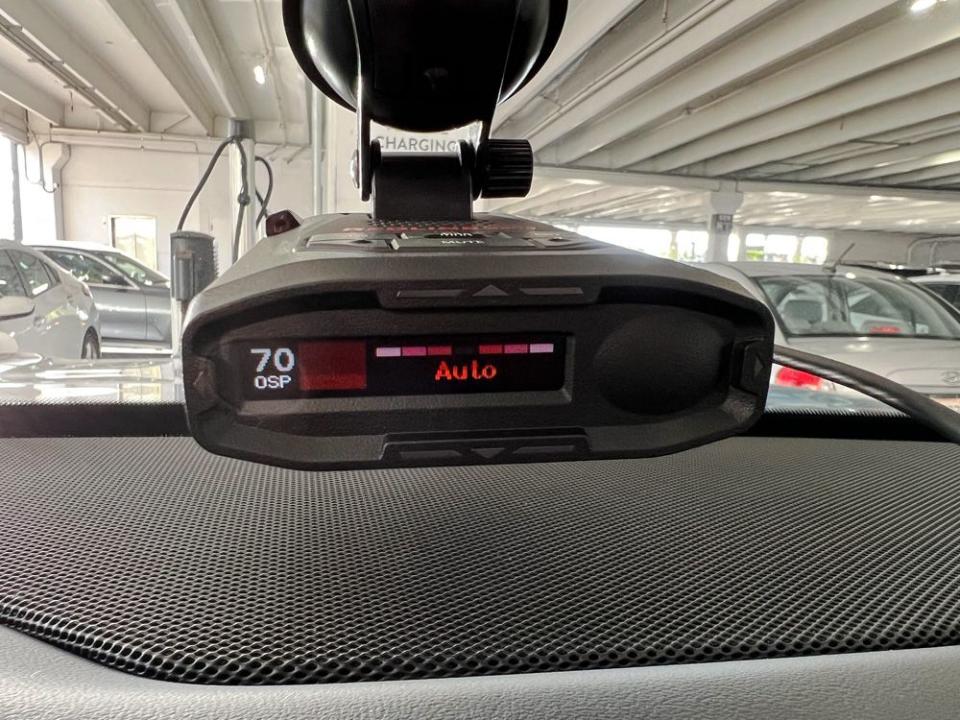
You Might Also Like

